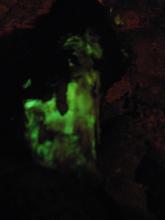In 1840 a botanist in Brazil encountered a group of children "playing with a glowing object that turned out to be a luminescent mushroom." He sent samples back to Kew Gardens, where it was named after him: Agaricus gardneri. The glow-in-the-dark mushroom was then promptly lost to science, and not rediscovered until a recent intrepid midnight rainforest survey by a San Francisco State research team.
The Brazilian phosphorescent mushroom is locally known as "flor-de-coco," for its habit of growing at the roots of a particular species of dwarf palm. It is one of the world's brightest phosphorescent mushrooms, almost bright enough to read newspaper by, according to some accounts. But it is by no means the only phosphorescent mushroom.
In the United States, the jack-o-lantern fungus can be easily mistaken for chanterelles. Which is a pity, because chanterelles are delicious, while the jack-o-lantern mushroom is poisonous. However, if you correctly identify the orange fungus (which grows in clumps on wood, unlike chanterelles which grow singly on the ground) and return after dark, you may be lucky enough to see its underside glowing an unearthly green.
Another phosphorescent fungus is a family of honey mushrooms, which have glowing filaments (mycelium) and which colonize rotting wood. These phosphorescent fungi filaments make chunks of rotting wood seem to glow after dark, a phenomenon which has long been called "foxfire" in the Ozarks and elsewhere.
Fungi seem to produce phosphorescence by breaking down a substance called luciferin, the same way that fireflies do. But they burn it constantly, not in bursts the way that animals do. In fact, phosphorescent fungi apparently phosphoresce 24 hours a day - it's just that we can only see it after dark!
Mushroom researchers (mycologists) do not yet know why mushrooms phosphoresce in the first place. In the animal world, there are three typical ways that phosphorescence is used: to attract a mate (as with fireflies), to ward off or confuse predators (as with small fish and phosphorescent zooplankton), or to entice a meal closer (as with the glowing lures of many deep-sea fish).
None of these reasons pertain to mushrooms, which are simply the fruiting body of the underlying fungus. A mushroom's biological purpose is to build and then drop spores. Mushrooms don't "care" if they are eaten, the way that an apple cares (because that is how its seeds are dispersed). In fact, many mushrooms are poisonous specifically to prevent themselves being eaten.
Why would a mushroom want to call attention to itself in the middle of the night? Only the glowing mushroom knows!
The Brazilian phosphorescent mushroom is locally known as "flor-de-coco," for its habit of growing at the roots of a particular species of dwarf palm. It is one of the world's brightest phosphorescent mushrooms, almost bright enough to read newspaper by, according to some accounts. But it is by no means the only phosphorescent mushroom.
In the United States, the jack-o-lantern fungus can be easily mistaken for chanterelles. Which is a pity, because chanterelles are delicious, while the jack-o-lantern mushroom is poisonous. However, if you correctly identify the orange fungus (which grows in clumps on wood, unlike chanterelles which grow singly on the ground) and return after dark, you may be lucky enough to see its underside glowing an unearthly green.
Another phosphorescent fungus is a family of honey mushrooms, which have glowing filaments (mycelium) and which colonize rotting wood. These phosphorescent fungi filaments make chunks of rotting wood seem to glow after dark, a phenomenon which has long been called "foxfire" in the Ozarks and elsewhere.
Fungi seem to produce phosphorescence by breaking down a substance called luciferin, the same way that fireflies do. But they burn it constantly, not in bursts the way that animals do. In fact, phosphorescent fungi apparently phosphoresce 24 hours a day - it's just that we can only see it after dark!
Mushroom researchers (mycologists) do not yet know why mushrooms phosphoresce in the first place. In the animal world, there are three typical ways that phosphorescence is used: to attract a mate (as with fireflies), to ward off or confuse predators (as with small fish and phosphorescent zooplankton), or to entice a meal closer (as with the glowing lures of many deep-sea fish).
None of these reasons pertain to mushrooms, which are simply the fruiting body of the underlying fungus. A mushroom's biological purpose is to build and then drop spores. Mushrooms don't "care" if they are eaten, the way that an apple cares (because that is how its seeds are dispersed). In fact, many mushrooms are poisonous specifically to prevent themselves being eaten.
Why would a mushroom want to call attention to itself in the middle of the night? Only the glowing mushroom knows!
